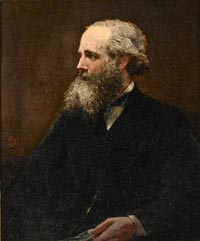
| Born: Jun 13, 1831 in Edinburgh, Scotland |
| Died: Nov 5, 1879 (at age 48) in Cambridge, England |
| Nationality: Scottish |
| Famous For: Maxwell’s theorem, Maxwell’s equations, Maxwell distribution, Maxwell’s demon, Maxwell’s discs, Maxwell speed distribution, and others |
| Awards: Smith’s Prize (1854), Adams Prize (1857), Rumford Medal (1860) and Keith Prize (1869–71) |
James Clerk Maxwell was born on June 13th, 1831 and passed away on November 5th, 1879 in the city of Edinburg, Scotland. Interestingly he was not born with the last name Maxwell, but rather Clerk. It was after acquiring an inheritance of a country estate in Middlebie, Scotland that he added the surname of Maxwell. During his life he made numerous discoveries in the field of physics that netted him great recognition.
From a very early age Maxwell had a keen unquenchable thirst to learn what made things work. Anything that moved in any way, or that made any noise at all had him scampering to discover what made them do what they do. Once, Maxwell’s mother added a note to the letter his father was sending to his Sister in-law regarding her young son. She wrote about his natural born inquisitiveness regarding all that moved, shone or even rang. She further wrote that Maxwell displayed a great deal of interest with the workings of keys, doors and locks. Additionally, she boasted to her sister-in-law that her son also studied the hidden path of steam as it evaporated into the air as well as many other things.
Education
Maxwell’s mother would play an important part in his early education, albeit brief, for she died when Maxwell was only 8 years old. After the death of his mother in 1839 Maxwell received his continued schooling from his father and his father’s sister-in-law; both of whom had an influential role in the young boy’s education. Maxwell’s formal education was initially unsuccessful and the 16 year old boy hired to teach the young Clerk-Maxwell was not long in staying. It is believed the young teacher was cruel and verbally abusive. Upon learning of the hired tutor’s behavior toward his young son, Maxwell’s father fired the tutor.
Sometime later, after a great deal of thought, young Maxwell was sent to a well-known Academy in Edinburg where he resided with his Aunt Isabella during class terms. He first derived an interest in art from his cousin who was an artist. However, due to living a sheltered life in his father’s country, the 10 year old Maxwell did not seem to adapt and fit in at the Academy. Maxwell dealt with a great deal of teasing from other boys without complaint until, at age 13, his social isolation ended when he befriended young Peter Taint and Lewis Campbell. These two boys were close in age to him and in the future years would both become well known scholars. They would continue their friendships with the young Maxwell throughout their lives. Maxwell’s scholarly interests spanned further than what was being taught in the classroom or even what they would be tested on. In fact, he displayed a keen interest in geometry and rediscovered standard polyhedrons before receiving any formal education on the subject. Although he won the school’s first place award for scripture biography, his academic work continued to go unrecognized. Maxwell’s diligence finally reaped him well deserved recognition when he was 13 years old. At this time he won his school’s medal for mathematical achievement and further took first prize in English and Poetry. At 14 Maxwell wrote an in-depth description of a way of drawing mathematical curves with the use of string, an ellipse, ovals and like curves with more than two special points. This written work, which was titled Oval Curves, was given to the Edinburg Royalty by an Instructor of Philosophy.
At 16, Maxwell left the Edinburg Academy and entered the University, also in Edinburg. He decided to continue his studies in the same field as he studied at the Academy and received tutoring from some well-versed men in the subjects of physics, mathematics, metaphysics, logic and philosophy. When Maxwell was 18 years of age he authored two more articles; the first regarded chemical equilibriums while the second was similar to the article written when he was at the Academy. It was decided he was too young to present this document to the Royal Family and so Maxwell’s tutor made the presentation on Maxwell’s behalf.
Leaving the Homeland
Maxwell transferred to the University of Cambridge when he was 19. He was already a mathematician but held a strong desire to obtain a fellowship. He soon was invited to enter the elite Cambridge Society of Apostils.
James Maxwell was recognized as one of the top physicists of his era and is well known for his theory of electromagnetism. He posited that the elements of light, electricity and magnetism were all intertwined within the exact same phenomena. Additionally, in one of his publications Maxwell demonstrated that magnetic and electric fields travel through space while moving at the speed of light as waves. He proposed that light, in fact, moved in a wavelike pattern in much the same fashion as the electric and magnetic fields did. The joining of light and electric phenomena led to the prediction of radio waves.
Although his life was relatively short, James Maxwell’s contributions to the theory of magnetism, as well as his other achievements, leave little wonder why he is thought to be one of the top physicists of all time.